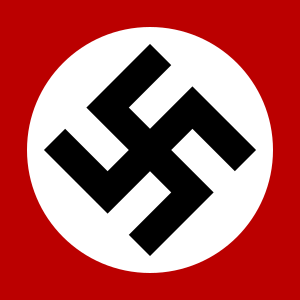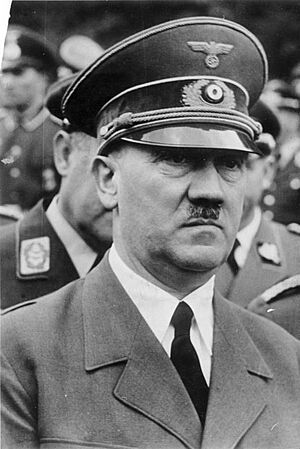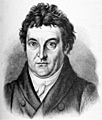Nazism facts for kids
Nazism (also called National Socialism; German: Nationalsozialismus) was a set of political beliefs linked to the Nazi Party in Germany. It began in the 1920s. The Nazi Party took power in 1933, starting what they called the Third Reich. They ruled Germany until 1945, when World War II ended.
The Nazis believed that only the "Aryan race" was strong enough to build nations. They thought other groups, especially Jewish people, were harmful. They blamed Jewish people for Germany's loss in World War I. They also blamed them for Germany's economic problems after the war. Because of this, the Nazis saw Jewish people as not only weaker but also as enemies of the "Aryan" people.
To put their racist ideas into action, the Nazis passed the Nuremberg Race Laws in 1935. These laws stopped non-Aryans and political opponents from working in government jobs. They also made it illegal for "Aryan" and "non-Aryan" people to have relationships.
The Nazis sent millions of Jewish people, Roma people, and others to concentration camps and death camps. There, they were killed. These terrible killings are now known as the Holocaust.
The word Nazi is a short form of Nationalsozialist in German. This means "supporter of the Nationalsozialistische Deutsche Arbeiterpartei" or "National Socialist German Workers' Party".
Contents
How the Nazis Came to Power
Adolf Hitler, who became the leader of Nazi Germany, wrote a book called Mein Kampf ("My Struggle"). In his book, he claimed that all of Germany's problems were caused by Jewish people who were secretly trying to harm the country. He also said that Jewish and communist politicians had planned the agreement in 1918 that ended World War I. He claimed they made Germany agree to pay huge amounts of money and goods as reparations.
On the night of February 27-28, 1933, the Reichstag building caught fire. This was where the German Parliament met. The Nazis blamed communists for the fire. However, many people who opposed the Nazis believed the Nazis themselves had started the fire to gain more power. On the same day, an emergency law called Reichstagsbrandverordnung was passed. The government said this law was to protect the country from harm.
This new law removed many civil rights that people had under the Weimar Republic. The Nazis used it against other political parties. Members of the communist and social-democratic parties were put in prison or killed.
The Nazis soon became the largest party in the parliament. By 1934, they had made all other political parties illegal. Democracy was replaced with a dictatorship, where one person has all the power. Adolf Hitler became the leader (Führer) of Germany.
Attacking Other Countries
As the leader of Nazi Germany, Hitler began moving Nazi armies into nearby countries. When Germany attacked Poland, World War II officially began. Western countries like France, Belgium, and the Netherlands were taken over by Germany. The Nazis planned to treat these countries as colonies.
However, in Eastern countries like Poland and the Soviet Union, the Nazis had even more terrible plans. They wanted to kill or enslave the Slavic peoples. Their goal was for German settlers to take over their land.
The Nazis also made alliances with other European countries, such as Finland and Italy. Many of these countries allied with Germany because they feared being taken over themselves. Through these alliances and invasions, the Nazis gained control of a large part of Europe.
The Holocaust
During the Holocaust, millions of Jewish people were targeted. Also, Roma people (sometimes called "Gypsies"), people with disabilities, homosexuals, political opponents, and many other groups were sent to concentration camps and death camps. These camps were mostly in Poland and Germany. The Nazis killed millions of these people in the concentration camps, often using poison gas.
The Nazis also killed millions by forcing them to do slave labor without enough food or clothing. In total, about 17 million people died during the Holocaust. Six million of these were Jewish people.
The Allies Win the War
In 1945, the Soviet Union took over Berlin after defeating the German army in Russia. The Soviet Red Army met the American and British armies. These armies had fought their way across Germany after invading Nazi Europe from Normandy in France on June 6, 1944. The Nazis lost the war because the Allies had many more soldiers and much more money than them.
During the invasion of Berlin, Hitler may have shot himself in an underground bunker with his new wife, Eva Braun. Other Nazi leaders also killed themselves, including Joseph Goebbels, who Hitler had named as his replacement just one day before. The Nazis gave up after the Red Army captured Berlin.
Trials for Nazi Leaders
After the war, the Allied governments, including the United States, Britain, and the Soviet Union, held trials for the Nazi leaders. These trials took place in Nuremberg, Germany. Because of this, they were called "the Nuremberg Trials."
The Allied leaders accused the Nazi leaders of war crimes and crimes against humanity. This included murdering millions of people in the Holocaust, starting wars, and being part of illegal groups like the Schutzstaffel (SS). Most Nazi leaders were found guilty by the court. They were sent to jail or executed by hanging.
Nazis After the War
There has not been a "Nazi" state since 1945. However, there are still people who believe in some of those old ideas. These people are often called neo-Nazis, which means "new" Nazis. Here are some examples of modern Nazi ideas:
- They believe that Germanic peoples (or sometimes "all white people") are better than all other races.
- They speak against Jewish people and sometimes other races. For example:
- They say that the Holocaust never happened, and that it was made up.
- They claim that Hitler was right to blame Jewish people for Germany's problems after World War I.
- They tell people to hate Jewish people and other groups.
- They believe that Jewish people have too much power in the world.
After the war, laws were made in Germany and other countries, especially in Europe. These laws make it illegal to say the Holocaust never happened. Some countries, like Germany, Austria, and France, also ban the use of Nazi symbols. This is to stop Nazis from using them and spreading their ideas.
Related pages
Images for kids
-
Johann Gottlieb Fichte, a key figure in early German nationalism
-
Arthur de Gobineau, who helped create the idea of the "Aryan race"
-
Houston Stewart Chamberlain, whose book The Foundations of the Nineteenth Century influenced German nationalism
-
The first trial of Nazis in Europe, held in Kaunas in 1935. The accused wanted the Klaipėda Region to be part of Germany.
-
Hitler in 1935 with Cesare Orsenigo, the Catholic Church's representative in Germany
-
A Nazi Party rally in Nuremberg, 1936
See also
 In Spanish: Nazismo para niños
In Spanish: Nazismo para niños















